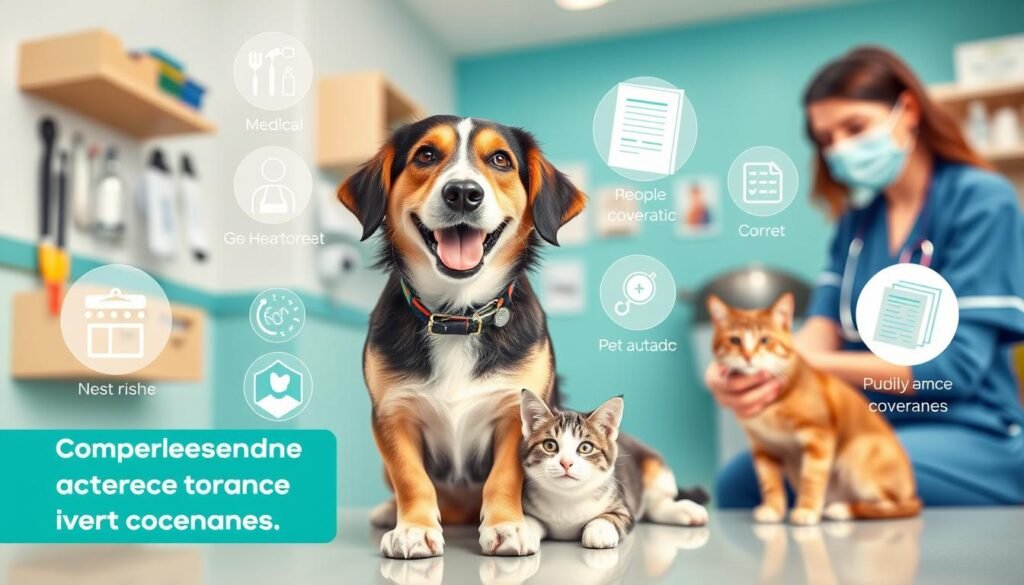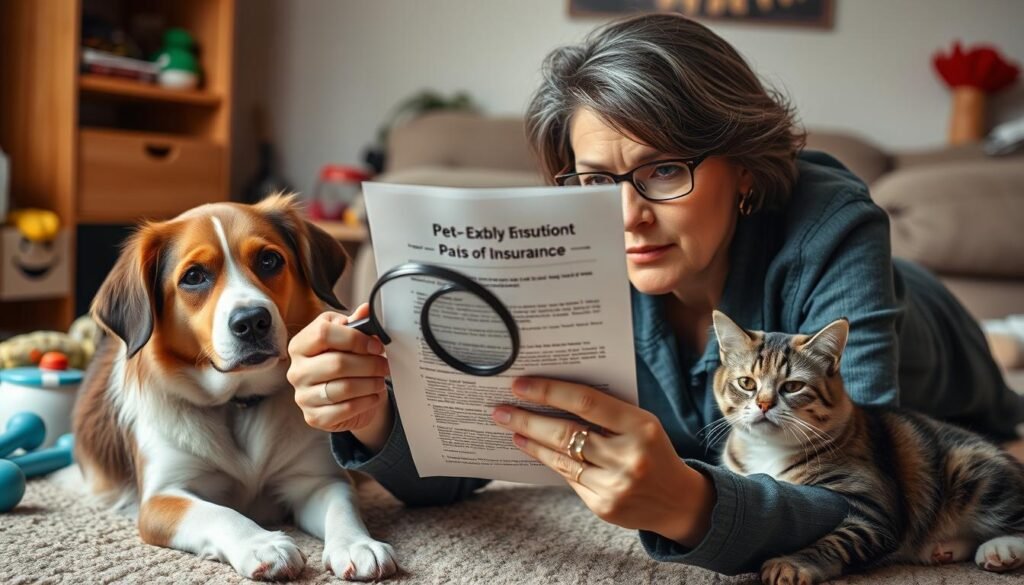Did you know ACL surgery for dogs can cost from hundreds to $7,000 for a TPLO procedure1? As a pet owner, dealing with pet insurance and ACL injuries can be tough. But don’t worry, this guide will help you understand your options and ensure your pet gets the best care.
Key Takeaways
- Pet insurance often covers ACL surgery for dogs, but policies have limits and exclusions.
- ACL surgery is a common treatment for torn ligaments in pets, with costs ranging from $2,000 to $6,000 per knee.
- Certain dog breeds, such as Labradors and German Shepherds, are more prone to ACL injuries.
- The recovery period for ACL surgery in dogs typically lasts 12-16 weeks.
- Pet insurance may have waiting periods before coverage for ACL injuries begins.
What is ACL Surgery for Pets?
Dogs and cats don’t have an ACL like humans, but they have a similar structure called the CCL. This ligament helps stabilize the knee joint and is a common issue in pets2. An injury to this ligament can cause pain, swelling, and lameness in the affected leg2.
Explaining ACL and CCL Injuries
ACL and CCL injuries are often used the same in vet talk, as they do the same job2. These injuries can be partial or complete tears, caused by sudden trauma or gradual wear and tear3. Some dog breeds, like Newfoundlands, are more likely to get CCL injuries2.
Common Signs of an ACL Tear
Pets with ACL/CCL injuries may show swelling and pain in the knee, lameness, and a dislike for exercise2. They might have trouble going up stairs or jumping because of knee pain2.
| Key Facts | Statistics |
|---|---|
| Pets with ACL/CCL injuries |
– More than 50% of dogs will experience a CCL rupture in the opposite limb after the initial injury2. – About 50% of dogs with CCL disease in one knee may develop similar issues in the other knee2. – Dogs are more likely to injure the ACL in their other leg if they have already had surgery in one leg3. |
| Cost of ACL/CCL Surgery |
– The average cost of CCL surgery for a dog is $2,299, with a range from $1,200 to $9,500 depending on location2. – ACL surgery for dogs can cost approximately between $1,500 to $10,0003. – The cost of ACL surgery can vary based on the type of surgery needed, the dog’s size, and the location of the veterinary hospital3. |
| Surgical Outcome |
– The long-term prognosis for CCL surgery is positive, with veterinarians seeing improvement in 85% to 90% of cases2. – Specific complications of CCL surgery include delayed healing of the bone, non-healing of the bone, and bone fracture2. – Complications with CCL surgery include adverse reactions to anesthesia, excessive bleeding, infection, and patellar luxation3. |
Surgery is often the treatment for ACL/CCL injuries, helping to stabilize the knee and reduce pain3. Pet owners should know that managing these injuries can be tough and may need ongoing care, including physical therapy and rehabilitation3.
Comprehensive vs. Accident-Only Pet Insurance
Choosing the right pet insurance is key for ACL surgery costs. Comprehensive pet insurance covers accidents and illnesses, making it a better choice for ACL surgery4. Accident-only pet insurance might not cover ACL surgeries, depending on the injury and policy exclusions4.
An ACL tear can happen suddenly, like from a fall or collision. In these cases, accident-only plans might help4. But, if the injury is from a degenerative condition or pre-existing issue, coverage might be denied4.
| Coverage Type | ACL Surgery Coverage |
|---|---|
| Comprehensive Pet Insurance | More likely to cover ACL surgery, as it includes both accidents and illnesses4. |
| Accident-Only Pet Insurance | May not cover ACL surgery, depending on the cause of the injury4. |
When picking a pet insurance plan, check the coverage and exclusions well.  This ensures your pet’s ACL surgery is covered. It helps avoid unexpected costs5.
This ensures your pet’s ACL surgery is covered. It helps avoid unexpected costs5.
How Pet Insurance Coverage Works for ACL Surgery
The Claims Process
If your pet gets an ACL injury and needs surgery, pet insurance can help with the costs6. Most policies cover ACL surgery, but some might have limits or exclusions6.
Here’s how it works: First, you’ll take your pet to the vet if they’re limping or moving stiffly6. The vet will check for an ACL tear and suggest surgery6. Then, you’ll pay the vet for the surgery upfront6.
After the surgery, you’ll file a claim with your insurance company6. You’ll need to send them an invoice from the vet6. If they approve your claim, you’ll get money back to help with the costs6. ACL surgery costs can range from $1,200 to $8,000, depending on your pet’s breed and the tear’s severity6.
Pet insurance can greatly impact the care your pet gets for an ACL injury6. While the claims process might seem complex, knowing how it works can help you get the financial support you need6.

Pre-Existing Conditions and Waiting Periods
Understanding pet insurance for pre-existing conditions and waiting periods is key. Most pet insurance plans don’t cover injuries or illnesses before your policy starts or during the initial waiting period7. If your pet has a history of ACL or joint issues, these might be seen as pre-existing and not covered.
The waiting period for ACL surgery can be longer, sometimes up to six months7. If your pet shows signs of an ACL injury after you’ve signed up for insurance, it might not be covered. This is because it’s considered a pre-existing condition.
Yet, some insurers might cover curable pre-existing conditions if your pet has been symptom-free for about 180 days8. But conditions like allergies, arthritis, cancer, and diabetes are usually not covered8.
It’s vital to read your pet insurance policy carefully. Understand the coverage, including any exclusions or limitations for pre-existing conditions and waiting periods7. This way, you can make the best choice for your pet’s health and ensure they’re covered.

In short, pet insurance has specific rules and waiting periods for pre-existing conditions789. By reviewing your policy and knowing these details, you can better understand pet insurance. This ensures your pet gets the care they need.
Bilateral Conditions and Exclusions
If your pet has had a torn ACL or CCL in one leg, they might hurt the other knee too. These issues on both sides are often not covered by pet insurance10.
Most pet insurance plans don’t cover bilateral conditions. For example, if your pet had a torn ACL on the right side before you got insurance, and then needed surgery on the left, it might not be covered1011.
Insurance companies usually don’t cover injuries to the second knee. This is because the risk of injury to the other knee is high after one side is hurt12. This is called a “bilateral exclusion.” It’s key to know these limits when picking a pet insurance policy.
Conditions like hip dysplasia are also often not covered if one side was affected before the policy started12. It’s important to read the policy details carefully. This way, you’ll know what’s not covered, like pre-existing and bilateral conditions.

Even with these exclusions, pet insurance can help with many unexpected vet bills. Knowing the limits helps you pick the best plan for your pet11.
Average Cost of ACL Surgery for Pets
ACL surgeries for pets can be expensive. The cost varies based on several factors. On average, it costs between $1,500 to $10,000, depending on the injury and procedure13. Pet insurance plans that cover accidents and illnesses are more likely to help with the cost13.
Factors Affecting Surgery Costs
The cost of ACL surgery depends on several things. These include the injury’s extent, your pet’s age, size, and health. Also, the medications used, your location, and the surgery type13. Some insurance companies have longer waiting periods for ACL injuries13.
There are also extra costs for follow-up care, pain meds, and rehabilitation. While ACL surgery costs range from $1,500 to $10,000, discounts might be available for bilateral surgeries or additional procedures13. Pet insurance providers like Embrace, Lemonade, and Fetch cover ACL surgery13. Monthly premiums for accident-only plans start at about $9, while full coverage plans are around $4213.
Recovery from ACL surgery for pets usually takes three to six months13. Sometimes, pets with partial ACL tears can be treated without surgery. This includes using orthopedic braces, supplements, and rest13.
does pet insurance cover acl surgery
When your furry friend gets an ACL injury, you might wonder if insurance will help with surgery costs. The answer varies based on your insurance plan and when the injury happened3.
Pet insurance often covers ACL surgery, but there are catches. If the injury was there before or during the waiting period, you might not get help. But, if it happens after the waiting period and isn’t a pre-existing condition, you might get some help with the costs3.
ACL surgery for dogs can cost between $1,500 and $10,000 in 2024. This depends on the surgery type and your vet’s skills3. Insurance can help with these costs, but how much varies by provider and plan. Some plans might not cover all types of ACL surgeries, so check your policy well.
Dogs with one ACL injury are more likely to hurt the other leg too3. This is something to think about when planning for your pet’s future. If your dog gets both ACLs injured, your insurance might have extra rules or limits.
Whether your pet insurance covers ACL surgery depends on several things. These include when the injury happened, your policy’s rules, and what your plan covers. Knowing these details helps you decide the best way to care for your pet’s health.
In short, most pet insurance plans do cover ACL surgery, but how much they cover can differ. It’s key to understand your policy’s limits and exclusions. Also, work closely with your vet to get the best care for your pet while using your insurance wisely.
Pet Insurance Companies Covering ACL Tears
If your pet needs ACL surgery, companies like13 Embrace Pet Insurance, Lemonade, and Fetch Pet Insurance can help. The cost of insurance varies based on several factors. These include the insurance company’s rates, your location, your pet’s age and breed, and the coverage level you choose13. Accident-only policies are cheaper but only cover sudden injuries, not gradual ones.
It’s key to know that13 pet insurance might have longer waiting periods for ACL injuries. This can be up to six months, which might lead to exclusions for pre-existing conditions. Some insurers, like13 Embrace Pet Insurance, also exclude bilateral conditions. This means injuries on the other knee might not be covered.
13 ACL surgery for pets can cost between $1,500 and $10,000 per knee. This cost depends on the injury’s extent, the pet’s age, size, health, medications, and location13. More expensive plans, like accident-only, are less likely to cover ACL surgery. But, they are cheaper than more inclusive plans.
FAQ
Does pet insurance cover ACL surgery?
What is ACL surgery for pets?
What are the common signs of an ACL tear?
What’s the difference between comprehensive and accident-only pet insurance coverage for ACL surgery?
How does the pet insurance claims process work for ACL surgery?
How do pre-existing conditions and waiting periods affect pet insurance coverage for ACL surgery?
How does bilateral conditions impact pet insurance coverage for ACL surgery?
What is the average cost of ACL surgery for pets?
FAQ
Does pet insurance cover ACL surgery?
Most pet insurance covers ACL surgery for knee ligament injuries. But, policies have limits and exclusions. Coverage depends on the injury’s timing, pre-existing conditions, and other factors.
What is ACL surgery for pets?
Dogs and cats have a cranial cruciate ligament (CCL), not an ACL like humans. Veterinarians often use ACL and CCL interchangeably. An ACL/CCL injury is a tear or rupture of the ligament that stabilizes the knee joint.
What are the common signs of an ACL tear?
Symptoms include swelling and pain in the knee, lameness, and difficulty using the leg. Your pet may also show decreased activity or reluctance to jump or go up stairs.
What’s the difference between comprehensive and accident-only pet insurance coverage for ACL surgery?
A: Comprehensive pet coverage (accident and illness) is more likely to cover ACL surgery. Accident-only plans might not cover it, depending on exclusions and injury circumstances.
How does the pet insurance claims process work for ACL surgery?
Notice your pet limping, then schedule a vet visit. The vet diagnoses an ACL tear and recommends surgery. You pay the vet directly and submit a claim to your insurance company with an invoice.
The company reviews your claim and, if approved, covers some or all costs with a reimbursement check or deposit.
How do pre-existing conditions and waiting periods affect pet insurance coverage for ACL surgery?
Pet insurance doesn’t cover injuries or illnesses before your plan starts or during the initial waiting period. ACL injuries often have a longer waiting period, like six months.
How does bilateral conditions impact pet insurance coverage for ACL surgery?
Pets with one ACL injury are likely to have trouble with the other. Most insurers exclude these conditions. If your pet had a torn ACL on one side before insurance, surgery on the other side might not be covered.
What is the average cost of ACL surgery for pets?
ACL surgeries cost between
FAQ
Does pet insurance cover ACL surgery?
Most pet insurance covers ACL surgery for knee ligament injuries. But, policies have limits and exclusions. Coverage depends on the injury’s timing, pre-existing conditions, and other factors.
What is ACL surgery for pets?
Dogs and cats have a cranial cruciate ligament (CCL), not an ACL like humans. Veterinarians often use ACL and CCL interchangeably. An ACL/CCL injury is a tear or rupture of the ligament that stabilizes the knee joint.
What are the common signs of an ACL tear?
Symptoms include swelling and pain in the knee, lameness, and difficulty using the leg. Your pet may also show decreased activity or reluctance to jump or go up stairs.
What’s the difference between comprehensive and accident-only pet insurance coverage for ACL surgery?
A: Comprehensive pet coverage (accident and illness) is more likely to cover ACL surgery. Accident-only plans might not cover it, depending on exclusions and injury circumstances.
How does the pet insurance claims process work for ACL surgery?
Notice your pet limping, then schedule a vet visit. The vet diagnoses an ACL tear and recommends surgery. You pay the vet directly and submit a claim to your insurance company with an invoice.
The company reviews your claim and, if approved, covers some or all costs with a reimbursement check or deposit.
How do pre-existing conditions and waiting periods affect pet insurance coverage for ACL surgery?
Pet insurance doesn’t cover injuries or illnesses before your plan starts or during the initial waiting period. ACL injuries often have a longer waiting period, like six months.
How does bilateral conditions impact pet insurance coverage for ACL surgery?
Pets with one ACL injury are likely to have trouble with the other. Most insurers exclude these conditions. If your pet had a torn ACL on one side before insurance, surgery on the other side might not be covered.
What is the average cost of ACL surgery for pets?
ACL surgeries cost between $1,500 and $10,000 or more per knee. Some providers offer discounts for both knees at once. Costs vary based on injury extent, pet’s age, size, health, medications, location, and surgery type.
Which pet insurance companies cover ACL surgery?
Companies like Embrace Pet Insurance, Lemonade, and Fetch Pet Insurance cover ACL surgery. The cost varies based on insurance rates, location, pet’s age and breed, and coverage amount.
,500 and ,000 or more per knee. Some providers offer discounts for both knees at once. Costs vary based on injury extent, pet’s age, size, health, medications, location, and surgery type.
Which pet insurance companies cover ACL surgery?
Companies like Embrace Pet Insurance, Lemonade, and Fetch Pet Insurance cover ACL surgery. The cost varies based on insurance rates, location, pet’s age and breed, and coverage amount.
Which pet insurance companies cover ACL surgery?
Source Links
- ACL injury – https://www.pawprotect.com/pet-insurance/cover-acl-injuries/
- How Much Does CCL (ACL) Surgery for Dogs Cost? – https://www.carecredit.com/well-u/pet-care/dog-acl-surgery-cost/
- How Much Does Dog ACL Surgery Cost? – https://www.lemonade.com/pet/explained/dog-acl-surgery-cost/
- Does Pet Insurance Cover Surgery? – https://www.progressive.com/answers/does-pet-insurance-cover-surgery/
- Does Pet Insurance Cover Surgery? | MetLife Pet Insurance’ – https://www.metlifepetinsurance.com/blog/pet-insurance/does-pet-insurance-cover-surgery/
- Does Pet Insurance Cover Cruciate Surgeries? – https://qz.com/advisor/pet-insurance/does-pet-insurance-cover-cruciate-surgeries/
- Pet Insurance and Pre-existing Conditions | ASPCA® Pet Health Insurance – https://www.aspcapetinsurance.com/research-and-compare/pet-insurance-basics/pet-insurance-and-pre-existing-conditions/
- Pet Insurance That Covers Pre-Existing Conditions – https://www.forbes.com/advisor/pet-insurance/pet-pre-existing-conditions/
- Does Pet Insurance Cover Pre-existing Conditions | Bankrate – https://www.bankrate.com/insurance/pet-insurance/does-pet-insurance-cover-pre-existing-conditions/
- Pet Insurance Coverage – https://www.healthypawspetinsurance.com/pet-insurance-coverage-and-exclusions
- What is Pet Insurance? | VCA Animal Hospitals – https://vcahospitals.com/know-your-pet/pet-insurance-for-dogs
- Does Pet Insurance Cover Pre-Existing Conditions? – https://www.petmd.com/general-health/does-pet-insurance-cover-pre-existing-conditions
- So Your Pet Needs ACL Surgery: Will Your Insurance Cover It? – https://www.investopedia.com/does-pet-insurance-cover-acl-surgery-8675532
